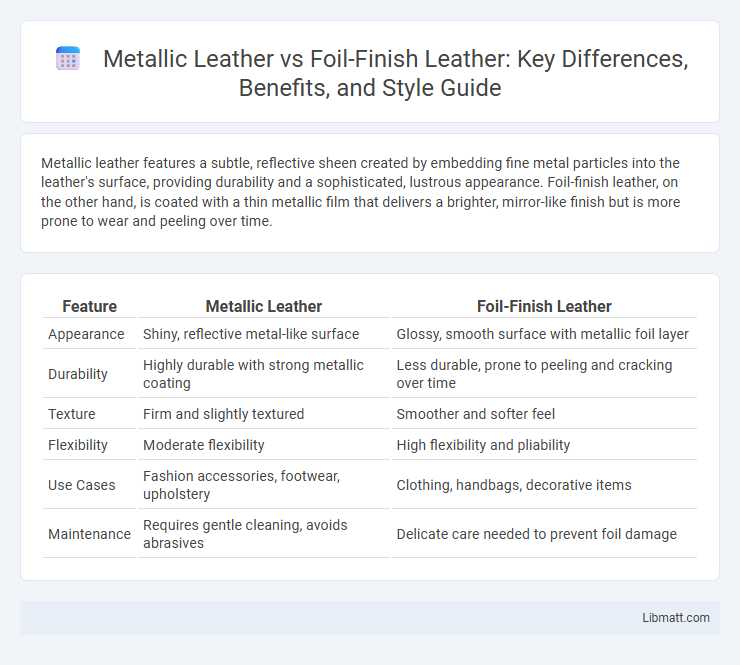Metallic leather features a subtle, reflective sheen created by embedding fine metal particles into the leather's surface, providing durability and a sophisticated, lustrous appearance. Foil-finish leather, on the other hand, is coated with a thin metallic film that delivers a brighter, mirror-like finish but is more prone to wear and peeling over time.
Table of Comparison
| Feature | Metallic Leather | Foil-Finish Leather |
|---|---|---|
| Appearance | Shiny, reflective metal-like surface | Glossy, smooth surface with metallic foil layer |
| Durability | Highly durable with strong metallic coating | Less durable, prone to peeling and cracking over time |
| Texture | Firm and slightly textured | Smoother and softer feel |
| Flexibility | Moderate flexibility | High flexibility and pliability |
| Use Cases | Fashion accessories, footwear, upholstery | Clothing, handbags, decorative items |
| Maintenance | Requires gentle cleaning, avoids abrasives | Delicate care needed to prevent foil damage |
Overview of Metallic Leather and Foil-Finish Leather
Metallic leather features a reflective, shiny surface created by applying metallic pigments or foils on genuine leather, offering durability and a luxurious aesthetic often used in fashion accessories and apparel. Foil-finish leather involves a heat-pressed metallic film layer, producing vibrant, uniform colors and textures with a slightly less natural feel but enhanced visual impact. Both types enhance leather's appeal through distinct surface treatments, catering to different design preferences and functional requirements in footwear, handbags, and upholstery.
Key Differences Between Metallic and Foil-Finish Leather
Metallic leather is created by applying metalized pigments or powders to the surface, resulting in a reflective, glossy finish with a rich depth of color. Foil-finish leather involves stamping or embossing a metallic foil onto the leather, producing a smooth, uniform shine that is often more delicate and prone to wear. Key differences include texture, durability, and the method of application, where metallic leather offers greater flexibility and resilience, while foil-finish leather provides a more consistent metallic appearance but less resistance to cracking or peeling.
How Metallic Leather Is Made
Metallic leather is crafted by applying a thin layer of metallic pigments or foil onto the leather's surface through a heat transfer or embossing process, creating a reflective and shiny effect. This technique enhances durability while preserving flexibility, making metallic leather popular for fashion accessories and footwear. Your choice between metallic and foil-finish leather depends on the desired aesthetic and texture, as foil-finish leather involves a thinner, less durable metallic coating often applied as a surface film.
The Process Behind Foil-Finish Leather
Foil-finish leather involves applying a thin metallic or pigmented layer onto the leather's surface through heat and pressure, creating a smooth, reflective coating that mimics metallic effects without altering the underlying material. This process uses specialized foil films that bond tightly to the leather, enhancing durability and allowing intricate patterns or vibrant colors to be achieved. Understanding this method helps you appreciate the unique appearance and texture differences compared to metallic leather, which is typically produced by integrating metal particles directly into the leather finish.
Visual Appeal: Shine, Texture, and Color Variations
Metallic leather boasts a lustrous, reflective shine with a smooth or subtly textured surface that enhances its eye-catching appeal, while foil-finish leather features a glossy, mirror-like sheen with a more uniform texture and sharper color contrasts. The color variations in metallic leather often appear multidimensional and iridescent, creating depth and richness, whereas foil-finish leather typically offers vibrant, solid hues with a high-gloss finish. Your choice between the two materials depends on whether you prefer a dynamic, shimmering effect or a sleek, polished look with consistent brightness.
Durability and Longevity Comparison
Metallic leather features a durable finish created by embedding metallic pigments directly into the leather surface, resulting in greater resistance to cracking and peeling over time. Foil-finish leather relies on a thin, surface-applied metallic film, which tends to wear off more quickly, especially in high-friction areas, reducing its lifespan. Consequently, metallic leather offers superior longevity and consistent appearance compared to foil-finish leather, making it ideal for long-term use in fashion and upholstery.
Common Uses in Fashion and Accessories
Metallic leather is widely used in high-fashion footwear, handbags, and statement jackets due to its reflective surface that adds a bold, luxurious touch to garments and accessories. Foil-finish leather, characterized by its thin metallic coating, is popular for wallets, belts, and small leather goods where a subtle shimmer complements everyday style without overpowering. Your choice between metallic leather and foil-finish leather depends on the desired intensity of shine and the type of accessory, balancing durability and visual impact in fashion applications.
Care and Maintenance Tips
Metallic leather requires gentle cleaning with a soft cloth and mild soap to preserve its reflective surface, avoiding harsh chemicals that can cause dullness or cracking. Foil-finish leather demands extra caution to prevent the foil layer from peeling or scratching, so keep it away from abrasive materials and store it in a cool, dry place. You can extend the lifespan of both types by regularly conditioning them with products designed specifically for delicate leather finishes.
Environmental Impact and Sustainability
Metallic leather often involves more intensive chemical processes and metal coatings, increasing its environmental impact compared to foil-finish leather, which typically uses lighter, surface-level metallic applications. Foil-finish leather generally requires less energy and fewer toxic materials during production, contributing to better sustainability profiles. When choosing your leather goods, considering foil-finish options can reduce ecological footprints while maintaining stylish metallic effects.
Choosing the Right Type for Your Needs
Metallic leather offers a durable, shimmering surface created by applying a metallic pigment, making it ideal for fashion items requiring long-lasting shine and wear resistance. Foil-finish leather achieves a high-gloss, reflective effect through a thin foil transfer process, perfect for eye-catching accessories and decorative elements that prioritize bold aesthetics. Choosing between metallic and foil-finish leather depends on your need for either durability and subtle sparkle or intense gloss and visual impact.
Metallic leather vs foil-finish leather Infographic

 libmatt.com
libmatt.com